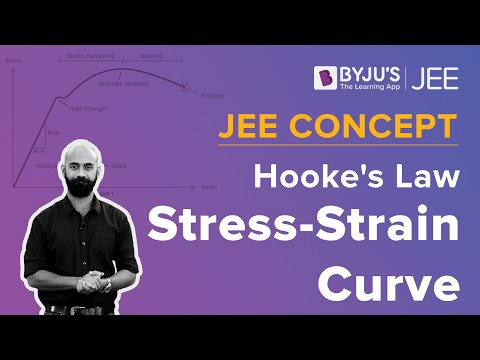In the 19th-century, while studying springs and elasticity, English scientist Robert Hooke noticed that many materials exhibited a similar property when the stress-strain relationship was studied. There was a linear region where the force required to stretch the material was proportional to the extension of the material. This is known as Hooke’s Law. In this article, let us learn about Hooke’s law in detail.
|
Table of Contents |
What is Hooke’s Law?
Stress and strain take different forms in different situations.Generally, for small deformations, the stress and strain are proportional to each other, and this is known as Hooke’s Law.
Hooke’s law states that the strain of the material is proportional to the applied stress within the elastic limit of that material.
When the elastic materials are stretched, the atoms and molecules deform until stress is applied, and when the stress is removed, they return to their initial state.
Mathematically, Hooke’s law is expressed as:
F = –kx
In the equation,F is the force, x is the extension length, k is the constant of proportionality known as spring constant in N/m.
Interested to learn more about spring? Below are the links:
Hooke’s Law Experiment
Consider a spring with load application, as shown in the figure.

Depending on the material, different springs will have different spring constants, which can be calculated. The figure shows us three instances, the stable condition of the spring, the spring elongated to an amount x under a load of 1 N, and the spring elongated to 2x under a load of 2 N. If we substitute these values in the Hooke’s law equation, we get the spring constant for the material in consideration.
Hooke’s Law Solved Example
A spring is displaced by 5 cm and held in place with a force of 500 N. What is the spring constant of the spring?
Solution:
We know that the spring is displaced by 5 cm, but the unit of the spring constant is Newtons per meter. This means that we have to convert the distance to meters.
Converting the distance to meters, we get
5 cm = 0.05 m
Now substituting the values in the equation, we get
F = –k.x
Now, we need to rework the equation so that we are calculating for the missing metric which is the spring constant, or k. Looking only at the magnitudes and therefore omitting the negative sign, we get
500 N/0.05 m = k
k = 10000 N/m
Therefore, the spring constant of the spring is 10000 N/m.
Hooke’s Law Graph
The figure below shows the stress-strain curve for low carbon steel.

From the origin till the proportional limit nearing yield strength, the straight line implies that the material follows Hooke’s law. Beyond the elastic limit between proportional limit and yield strength, the material loses its elasticity and exhibits plasticity. The area under the curve from origin to the proportional limit falls under the elastic range. The area under the curve from a proportional limit to the rupture/fracture point falls under the plastic range.
The material’s ultimate strength is defined based on the maximum ordinate value given by the stress-strain curve (from origin to rupture). The value provides the rupture with strength at a point of rupture.
The video explains to you the general stress-strain graph of an elastic material experiencing tensile load and what are various stages in it. Within the elastic limit it follows Hooke’s law. As we keep on increasing the load, other stages and points like proportionality limit, yield point, fracture point, ultimate tensile strength are achieved, and they have been well explained in this video.

Hooke’s Law Applications
Following are some of the applications of Hooke’s Law:
- It is used as a fundamental principle behind the manometer, spring scale, the balance wheel of the clock.
- Hooke’s law sets the foundation for seismology, acoustics and molecular mechanics.
Hooke’s Law Disadvantages
Following are some of the disadvantages of Hooke’s Law:
- Hooke’s law ceases to apply past the elastic limit of a material.
- Hooke’s law is accurate only for solid bodies if the forces and deformations are small.
- Hooke’s law isn’t a universal principle and only applies to the materials as long as they aren’t stretched way past their capacity.
Frequently Asked Questions – FAQs
Does Hooke’s Law apply to all materials?
Is Hooke’s Law linear?
When does Hooke’s Law fail?
When is Hooke’s Law negative?
Why do we need Hooke’s Law?
Stay tuned to BYJU’S and Fall in Love with Learning!




This website really helped me in my exams and I have leant lot of things from this website, thanks byjus!
Good website for Teachers of Physics